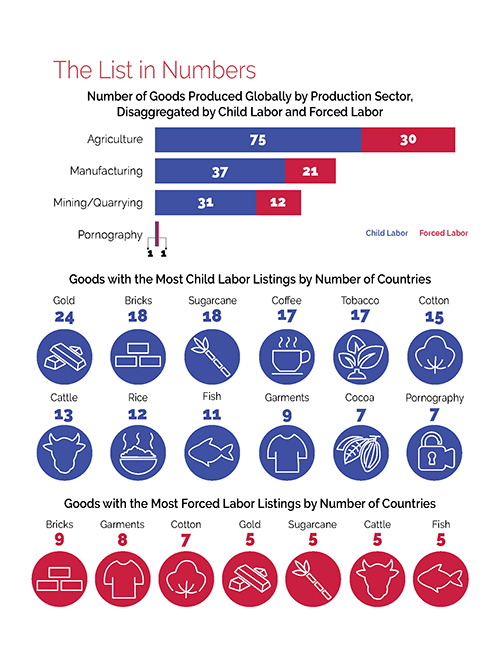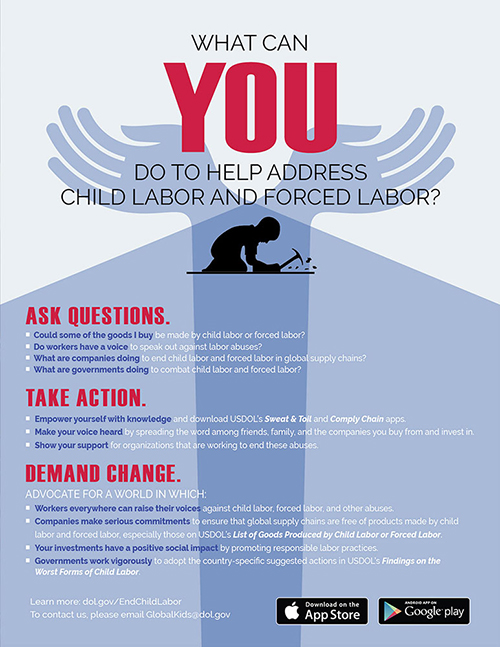List of Goods Produced by Child Labor or Forced Labor
The Bureau of International Labor Affairs (ILAB) maintains a list of goods and their source countries which it has reason to believe are produced by child labor or forced labor in violation of international standards, as required under the Trafficking Victims Protection Reauthorization Act (TVPRA) of 2005 and subsequent reauthorizations. The List of Goods Produced by Child Labor or Forced Labor comprises 159 goods from 78 countries and areas, as of September 28, 2022.
ILAB maintains the List primarily to raise public awareness about forced labor and child labor around the world and to promote efforts to combat them; it is not intended to be punitive, but rather to serve as a catalyst for more strategic and focused coordination and collaboration among those working to address these problems.
Publication of the List has resulted in new opportunities for ILAB to engage with foreign governments to combat forced labor and child labor. It is also a valuable resource for researchers, advocacy organizations and companies wishing to carry out risk assessments and engage in due diligence on labor rights in their supply chains.
The countries on the List span every region of the world. The most common agricultural goods listed are sugarcane, cotton, coffee, tobacco, cattle, rice, and fish. In the manufacturing sector, bricks, garments, textiles, footwear, carpets, and fireworks appear most frequently. In mined or quarried goods, gold, coal and diamonds are most common.
ILAB published the initial TVPRA List in 2009 and updated it annually through 2014, following a set of procedural guidelines that were the product of an intensive public consultation process. ILAB now updates and publishes the List every other year, pursuant to changes in the law.
Procedural Guidelines
On January 25, 2024, ILAB's Office of Child Labor, Forced Labor, and Human Trafficking published Procedural Guidelines for the development and maintenance of the List of Goods from countries produced by child labor or forced labor in violation of international standards.
| Country/Area | Good | Exploitation Type |
|---|---|---|
| Argentina | Cotton | Child Labor |
| Azerbaijan | Cotton | Child Labor |
| Benin | Cotton There are reports that children ages 6-17 are forced to produce cotton in Benin. Cotton is grown primarily in the north, such as in Banikoara, and according to NGOs and international organizations, many of the children are trafficked or migrate to this area from other parts of the country, or from Burkina Faso or Togo. Some children are lured by traffickers with false promises about working conditions or terms. Some children work on year-long contracts and are not allowed to leave until the end of the year. They are paid only at the end of the contract, once the cotton is sold, but most children report that they do not receive their full payment, and some are not paid at all. Children usually live with their employer, and do not receive sufficient food. |
Child Labor, Forced Labor |
| Brazil | Cotton | Child Labor |
| Burkina Faso | Cotton There are reports of children ages 10-17 producing cotton under conditions of forced labor in Burkina Faso. According to an NGO report containing the most recently available data on the eastern region of the country, it is estimated that as many as 50 percent of all boys aged 10 and above migrate or are trafficked to work for a year; most work on cotton farms in Tapoa or Kompienga. Children are also trafficked from around the country to work on cotton farms in Houet and Tuy provinces. Some children are forced to sow, weed, and harvest the cotton in hazardous conditions; some work under threats of abuse or withholding of payment. They usually live with their employer, and do not receive sufficient food. These children are lured by recruiters or traffickers with false promises of payment or gifts such as a bicycle. The children work on 12 or 17 month contracts and are prohibited from leaving to return home until the end of the contract. They are paid only when the cotton is sold and they have completed their contract, but most report that they do not receive their full payment, and some receive no payment at all. |
Child Labor, Forced Labor |
| China | Cotton There are reports that children are forced to pick cotton in China. Reports from an NGO and the U.S. Government indicate that children in the Xinjiang Uighur Autonomous Region and in Gansu province are mobilized through schools and required by provincial regulations to work during the autumn harvest. According to the most recently available estimates, between 40,000 and 1 million students are mobilized annually for the harvest, beginning as early as the third grade. Most children are paid little if at all, after deductions for meals, transportation, and payments to the school. These students are required to pick daily quotas of cotton or pay fines, and performance in the cotton harvest is assessed for the students' promotion to higher grade levels. |
Child Labor, Forced Labor |
| Egypt | Cotton | Child Labor |
| India | Cotton | Child Labor |
| Kazakhstan | Cotton | Child Labor, Forced Labor |
| Kyrgyz Republic | Cotton | Child Labor |
| Mali | Cotton | Child Labor |
| Pakistan | Cotton | Forced Labor |
| Tajikistan | Cotton There are reports that children ages 14-17 and some as young as 7 are forced to work during the annual cotton harvest in Tajikistan. Monitoring teams discover multiple cases of compulsory mobilization across several districts of the country each year. In these cases, school officials mobilize classes to work in the harvest and teachers supervise them in the fields. Some children receive threats regarding exams, grades, and even expulsion from school for refusal to work. The children are typically sent to the fields after class hours. Farmers negotiate directly with the schools to mobilize the students to work, and the schools may keep some or all of the children's wages. Some of the children are required to pick a quota of 66 pounds of cotton daily. |
Child Labor, Forced Labor |
| Turkey (Türkiye) | Cotton | Child Labor |
| Turkmenistan | Cotton | Child Labor, Forced Labor |
| Zambia | Cotton | Child Labor |
| India | Cottonseed (hybrid) There are reports that children, especially girls ages 6-14, are forced to produce hybrid cottonseed in India. Cottonseed production, and cottonseed farms with bonded child laborers, are reported to be concentrated in the state of Andhra Pradesh. According to NGO reports, between 400,000 and 450,000 children are working in the production of hybrid cottonseed, many working as forced or bonded labor. Some of these children are bonded to their employer, forced to work to pay off the debt of advanced payments made to their parents. Some children are forced to work with toxic pesticides. |
Child Labor, Forced Labor |
| Ghana | Textiles There is evidence that children ages 5 to 14 are involved in the weaving of textiles in Ghana. Based on an analysis of the Ghana Living Standards Survey, an estimated 23,856 child laborers are involved in the weaving of textiles. There are numerous health and safety issues associated with the textile industry. These hazards include chemical exposure from the processing and dyeing of materials, exposure to cotton and other organic dusts, musculoskeletal stresses, and noise exposure. The release of this survey demonstrates the Government of Ghana’s commitment to addressing child labor and its acknowledgement that data collection is vital to the design and implementation of sound policies and programs. |
Child Labor |
| China | Thread/Yarn Reports indicate that more than 2,000 adult Uyghur and ethnic Kazakh workers have been involuntarily transferred out of Xinjiang to yarn factories in the east and forced to produce thread/yarn products. It also is likely that many others are subjected to forced labor at yarn factories within Xinjiang, particularly for cotton yarns. Victim testimonies, news media, and think tanks report that factories, including for thread/yarn, frequently engage in coercive recruitment; limit workers’ freedom of movement and communication; and subject workers to constant surveillance, retribution for religious beliefs, exclusion from community and social life, and threaten family members. Further, workers may undergo re-education to eradicate “extremism.” More broadly, according to varied estimates, at least 100,000 to hundreds of thousands of Uyghurs, ethnic Kazakhs, and other Muslim minorities are being subjected to forced labor in China following detention in re-education camps. In addition to this, poor workers in rural areas may also experience coercion without detention. Workers can be placed at factories within the Xinjiang Uyghur Autonomous Region, where the camps are located, or be transferred out of Xinjiang to factories in eastern China. |
Forced Labor |
your hand? Download ILAB's Sweat & Toil App today!
Are you a company looking to fight child labor and forced labor in supply
chains?





